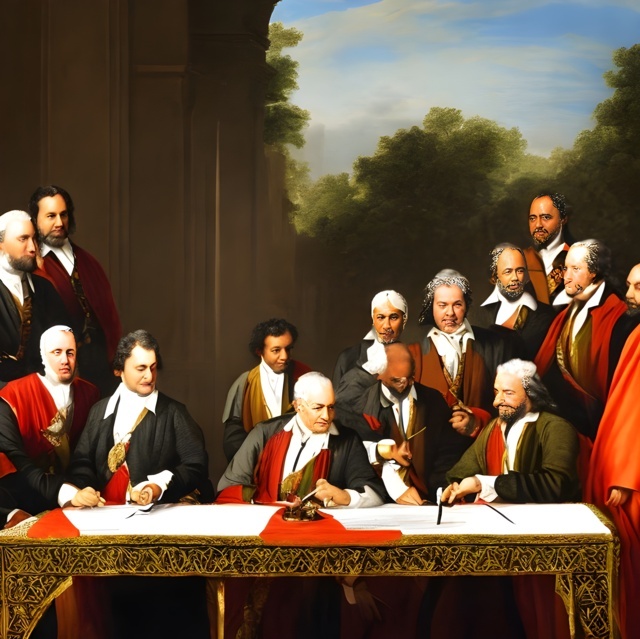In the annals of history, certain events stand out as pivotal moments that shape the course of nations and regions. One such event is the Treaty of Yandabo, signed in 1826. This treaty marked the end of the First Anglo-Burmese War and had far-reaching consequences for both British India and the Kingdom of Burma. In this blog post, we will delve into the details of the treaty, its historical context, and its after-effects.
Historical Context
To understand the significance of the Treaty of Yandabo, we must first explore the historical context in which it took place. The early 19th century was a time of great geopolitical changes in Southeast Asia. The British Empire, expanding its influence in the region, sought to secure its trade routes and protect its interests in British India. Meanwhile, the Kingdom of Burma, under the rule of King Bagyidaw, aimed to maintain its independence and resist British encroachment.
First Anglo-Burmese War
The First Anglo-Burmese War, which lasted from 1824 to 1826, was a result of escalating tensions between the British East India Company and the Burmese Kingdom. The British, driven by their desire for territorial expansion and control over trade, launched a military campaign against Burma. The war witnessed several significant battles and sieges, with both sides suffering heavy casualties.
The Treaty of Yandabo
After years of conflict, the Treaty of Yandabo was signed on February 24, 1826. The treaty, negotiated by General Sir Archibald Campbell on behalf of the British and the Burmese court, brought an end to the hostilities. Its key provisions included the following:
Cession of Territory: Under the treaty, Burma ceded the provinces of Arakan (Rakhine) and Tenasserim (Tanintharyi) to the British Empire. This marked a significant loss of territory for the Burmese Kingdom.
Trade and Commerce: The treaty opened up trade between British India and Burma, granting the British access to Burmese markets and resources. It also established favorable trade conditions for British merchants.
Indemnity: Burma was required to pay a large indemnity to the British as compensation for the costs of the war. This further strained the Burmese economy and weakened the kingdom’s position.
After-Effects
The Treaty of Yandabo had profound and lasting effects on both British India and the Kingdom of Burma.
British Expansion: The treaty solidified British control over key territories in Southeast Asia, providing a strategic advantage for further expansion in the region. It paved the way for the eventual annexation of Burma by the British Empire in 1885.
Economic Transformation: The treaty opened up new avenues for trade and commerce, benefiting British merchants and stimulating economic growth in British India. However, it also led to the exploitation of Burmese resources and contributed to the decline of the Burmese economy.
Cultural Exchange: The British presence in Burma brought about cultural exchanges between the two nations. This resulted in the introduction of Western ideas, technologies, and administrative systems in Burma, shaping its future trajectory.
Conclusion
The Treaty of Yandabo marked a turning point in the history of Southeast Asia. It represented the triumph of British imperialism and the beginning of a new era of British dominance in the region. For Burma, the treaty brought about territorial loss, economic challenges, and cultural transformations. The repercussions of this treaty continue to reverberate in the modern-day, shaping the political, economic, and cultural landscape of Myanmar.
References
– Smith, M. L. (1991). Burma: Insurgency and the Politics of Ethnicity. Zed Books.
– Charney, M. W. (2009). A History of Modern Burma. Cambridge University Press.
– Harvey, G. E. (1925). History of Burma: From the Earliest Times to 10 March 1824. Longmans, Green and Co.
Tags
Divi Meetup 2019, San Francisco
Related Articles
Unappreciated Greatness
Life and Legacy of Jahangir of the Mughal Empire. Jahangir ruled over one of the largest empires in human history during his lifetime, yet few people outside of South Asia have heard of him. I aim to shed light on the life and legacy of this remarkable figure,...
The Plague Doctor’s Diary
A Personal Account of the Turin Epidemic of 1656. I am writing this diary to record my experiences and observations as a plague doctor in Turin, the capital of the Duchy of Savoy, during the terrible epidemic that has afflicted this city and its surroundings since the...
The Timeless Beauty of Bustan
Unveiling the Secrets of Saadi Shirazi's Masterpiece.In the realm of Persian literature, few works have captured the essence of love, spirituality, and morality quite like Bustan (The Orchard) by Saadi Shirazi. This 13th-century masterpiece has left a lasting impact...
Stay Up to Date With The Latest News & Updates
Explore
Browse your topics of interest using our keyword list.
Join Our Newsletter
Sign-up to get an overview of our recent articles handpicked by our editors.
Follow Us
Follow our social media accounts to get instant notifications about our newly published articles.









